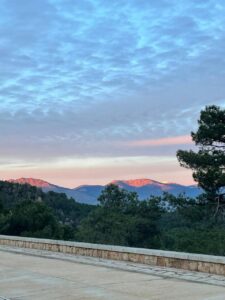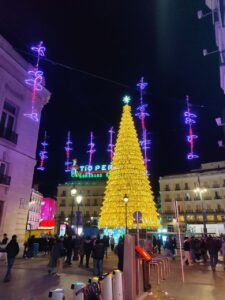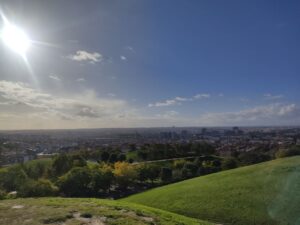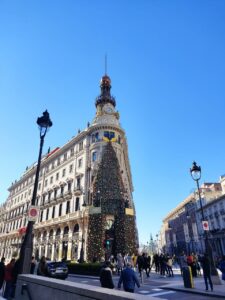- Political Science Ma.
- Spain, Madrid
- Goethe-Institut Madrid
- 09/2023 – 12/2023
- application process

© Dinah Schmidt
I started learning Spanish during my bachelor’s degree and had long planned to spend some time in Spain. In September 2022 I applied for the three-month internship in the cultural department of the Goethe-Institut Madrid. The online application consisted of my CV, a certificate of study, and a letter of reference from one of my professors/lecturers. In addition, i was required to answer a few questions about my previous experience, my interests, and my ideas. Then, in December, I received my acceptance on time as a Christmas present. Since then, I have been improving my Spanish skills with language courses and looking forward to my stay. In the summer of 2023, as the start of my internship approached, I started to prepare myself more intensively. Among other things, I studied the history of the city and the cultural offerings and scenes. Then it all started in mid-August! I combined the outward journey with a road trip through Belgium, France, and Spain. Over three weeks, we explored the coastal strip from Bordeaux to Llanes and then travelled through the mountains to Madrid. The traffic on Madrid’s motorways is a definite turn-off!!!
- Accommodation and Living Expenses
I knew from other reports that it would be very difficult to find accommodation and that I would have to be careful not to get screwed. As I didn’t have time to travel a few weeks before the start of the internship to look for a flat on the spot (or preferred to spend the time travelling), I used the Spotahome app. This gave me the certainty that the flat definitely existed and the deposit was only transferred to the landlord after I had given feedback that the flat looked as advertised.

© Dinah Schmidt
Of course, this security also came at a cost. In hindsight, I would recommend looking for accommodation locally rather than from Germany – but it was important for me to have a firm commitment for a room before the start of the internship. I lived in a shared flat with four people who were all only in Madrid for a few months to study. The flat was on the edge of a very nice neighbourhood (Salamanca) on a large roundabout – fortunately in the back building. My room was very small but nicely furnished and had a window. The flat only had a small kitchen, was very noisy and all in all was not in very good condition. The rent was 570 euros per month (!!!) which is very high for this property compared to German rents. Especially when you consider the difference in income between Germany and Spain. In the end, the decisive factor for me was that the Goethe-Institut was easy to reach from the flat. It was just under 25 minutes on foot and a quarter of an hour by metro without changing trains. The cost of living was not much lower than in Germany, only bar and restaurant meals were slightly cheaper.
- Everyday life/the internship
The working hours at the institute were Monday to Friday from 9:00 to 18:00. As part of the cultural work, events were regularly scheduled in the evening, which provided a great deal of flexibility in terms of time on site. On the one hand, the internship involved several continuous tasks and,

© Dinah Schmidt
on the other, offered me a wide range of opportunities to get involved in events. One regular task was to fill the Goethe-website-programme with content and revise it. I also provided support in the areas of communication and social media presence. This included creating events, application posts and reminders, but also conducting interviews with various artists/residents. Another very enjoyable and exciting task was looking after the residents and the institute’s guest flats. I had an overview of when an artist was arriving and departing and was able to welcome them. As a result, I got to know many artists (dance, theatre, cinema, sound, painting, …), theorists and researchers from all over the world during my internship. As part of the FLIPAS-project, workshops on a wide range of topics were made possible through the cooperation of several European cultural institutes in Madrid, cultural institutions and social organisations. These workshops took place in social organisations, museums or other institutes and focused on enabling young people in difficult circumstances to take part in cultural projects, establish contact with international artists, get them excited about the topics and create a great group experience together. As part of this project, I was able to take part in almost all the workshops and assist with translating and documenting them. This allowed me to get to know cultural and social centres, visit theatres and museums in Madrid’s city centre and the surrounding area, and network with a wide variety of people involved in cultural work.
- Free time & tips
The weather in Madrid was wonderful. We could sit outside until the beginning/mid-November and even in winter it was light until 6 p.m. and most days were characterised by bright sunshine. People’s rhythms start and end later than in Germany. The attitude to life is more relaxed and people get together longer in the evening and eat later and more extensively. I can definitely recommend the tapas culture. At the institute, six of us shared an office and were able to spend our breaks together and explore the city. We visited the large and smaller museums in Madrid and took the opportunity to visit some theatres and information events on various topics via the institute. The Reina Sofía Museum has a collection of recent Spanish art and exhibits documents from Spain’s history of protest – I was very impressed. I should not forget to mention the beautiful Retiro Park and the very picturesque and culturally interesting

© Dinah Schmidt
neighbourhoods of Lavapiés, Malasaña and La Latina. Madrid never sleeps – In the evenings and at the weekend, I visited some of the countless beautiful bars and clubs. (Favourite bar here: La Venencia – a quaint pub with an interior from the last century, where the Republicans met during the Civil War, with good sherry and delicious tapas) On the long weekends, I went on a trip to Valencia with friends, hiked the mountain regions around Madrid (Navacerrada was very nice), visited the nearby city of Toledo and the historical memorial site “Valle de Cuelgamuros” (also highly recommended). I really liked the Tío Pío Park in the Vallecas neighbourhood for its beautiful views over the city and, of course, the views from the various rooftop bars.
- Conclusion
To summarise, I can definitely recommend an experience abroad in Madrid and an internship in the cultural department at the Goethe-Institut Madrid. I really enjoyed it and the tasks I was given enabled me to surpass myself and make lots of contacts in Madrid and Spain. This experience abroad has also made me want to take on more projects abroad in the future, especially in Spanish-speaking countries. Finally, I have grown very fond of the people I met in Madrid, and I look forward to maintaining these contacts.



Leave a Reply